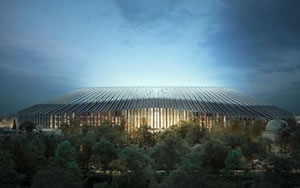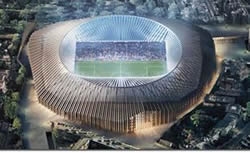Council Agrees to Overrides Injunction Threatening Chelsea Stadium Development
But family living yards from Stamford Bridge could continue legal battle
As expected, Hammersmith & Fulham council has agreed to use statutory powers to override an injunction brought by a local family which could have halted Chelsea Football Club's plans to build a new stadium.
The decision was made at meeting of the council's Cabinet on Monday, 15 January
The injunction was taken out last May by the Crosthwaite family, who have lived in Stamford Cottages for 50 years. These cottages are just yards away from the ground and look directly across the railway line at the stadium.
The family took out the injunction when they discovered the proposed 60,000 capacity stadium would interfere with their right to light, casting a permanent shadow over parts of their home.
Chelsea has been actively pursuing deals with a number of local residents over their 'right to light' which, under English law, gives a landowner the right to receive sunlight through defined openings or gaps in buildings on his or her land.
However, the BBC reports that the offer of a six-figure compensation sum plus £50,000 of legal advice could not persuade the Crosthwaites to waive the 'right to light' in their three-bedroom home.
Chelsea, which has been owned by Russian billionaire Roman Abramovich since 2003, told the council he new stadium would be 'undeliverable' and it would be unable to start development work or secure financing while there remained a risk that the injunction proceedings could succeed.
Therefore, it called on the local council to intervene and take advantage of planning laws to stop the injunction effectively ending the planned development.
In response, the council's Cabinet agreed on Monday to use its powers under planning law to buy the air rights over part of Stamford Bridge and the railway line which sits between the stadium and Stamford Cottages.
It agreed to acquire an interest in land - owned by Network Rail and Transport for London - in order to engage section 203 of the Housing and Planning Act 2016, which would override the "right to light" principle.
The council can now lease the land back to Chelsea and railway operators Network Rail. This means the property owners are entitled to compensation but are not able to prevent the redevelopment.
A report for councillors, drawn up by head of planning and regeneration John Finlayson said: "There is a compelling case in the public interest for the council to acquire the land for planning purposes and enable the development to proceed and the public benefits to be realised."
After the council's decision, a Chelsea spokesman said: "We are grateful to Hammersmith and Fulham Council for their decision, which is the latest step on our journey towards redeveloping of our historic home.
"The new stadium at Stamford Bridge will ensure the long-term future of the club in Fulham, create a world-class match-day experience for fans and allow us to increase our investment in the local community.
"It will be a new destination that compares to other great stadia around the globe and strengthen London's iconic status as the world's leading city of sport."
However, this may not be the end of the dispute as the family also believe Chelsea's attempt to effectively sidestep the injunction with the help of Hammersmith and Fulham council is not in the public interest and possibly illegal.
Their house is in the neighbouring Royal Borough of Kensington and Chelsea, which they say has been firmly opposed to the development, and they also say they will seek further legal advice.
The council approved the redevelopment of Stamford Bridge in January, which was then rubber-stamped by the mayor of London, Sadiq Khan, at the end of March.
The Premier League club, owned by Russian billionaire Roman Abramovich and which has so far splashed out close to £150m on players this summer, had wanted to start work by now with completion of the new stadium by summer 2021.
However, as we revealed in June, the club's move has been delayed until the end of the 2018/19 season at the earliest.
The team is expected to play its home games at Wembley stadium while work is carried out.
The scheme has also been given a green light by Mayor Sadiq Khan, following following the approval granted by H &F Council's Planning and Development Control committee on 11 January last year.
You can read the details of the council's decision here.

The club is hoping to demolish the current stadium along with all the other buildings on the site including flats, hotels and health club and build a new stadium on the existing Stamford Bridge site which will hold 60,000 spectators instead of the current total of 41,500 and include an elevated walkway over the District and West London railway lines.
The stadium has been designed by architects by Herzog & de Meuron, who also designed the Beijing Olympic Stadium and is expected to cost owner Roman Abramovich upwards of £500 million.
On its website, Chelsea FC said: "This is the latest significant step toward redevelopment of the stadium and the delivery of the extensive local community programme.
"Further steps lie ahead, both during and after the planning process, before construction work can commence.
"We continue to collaborate with all stakeholders and will keep you informed of progress made.
"We would like to acknowledge all residents, businesses and other parties locally who are engaging with us during the process."
The demolition and and building works could begin in the summer of 2018 and are scheduled to last three years with the new stadium open to the public by 2021.
Matches are expected to be moved to a temporary home during the building works, with Wembley Stadium reportedly the most likely option.
The club's planning application, which was slightly revised in August 2016, is as follows:
Demolition of existing stadium and buildings within Stamford Bridge Grounds and construction of a new 60,000 capacity football stadium (Class D2) with ancillary stadium-related uses including a Combined Heat and Power (CHP) plant, Club shop, kiosks and museum; restaurant/café (Class A3); together with the construction of a Decking Platform over the District Line railway to the north-west and a Decking Platform over the Southern mainline railway to the east; external concourse areas; associated excavation works; new pedestrian access from Fulham Broadway Station and Fulham Road; new vehicular access via Wansdown Place; car parking; landscaping and related works. (‘Amended Proposed Development’).
You can read the full application and hundreds of supporting documents here.
January 11 , 2017
